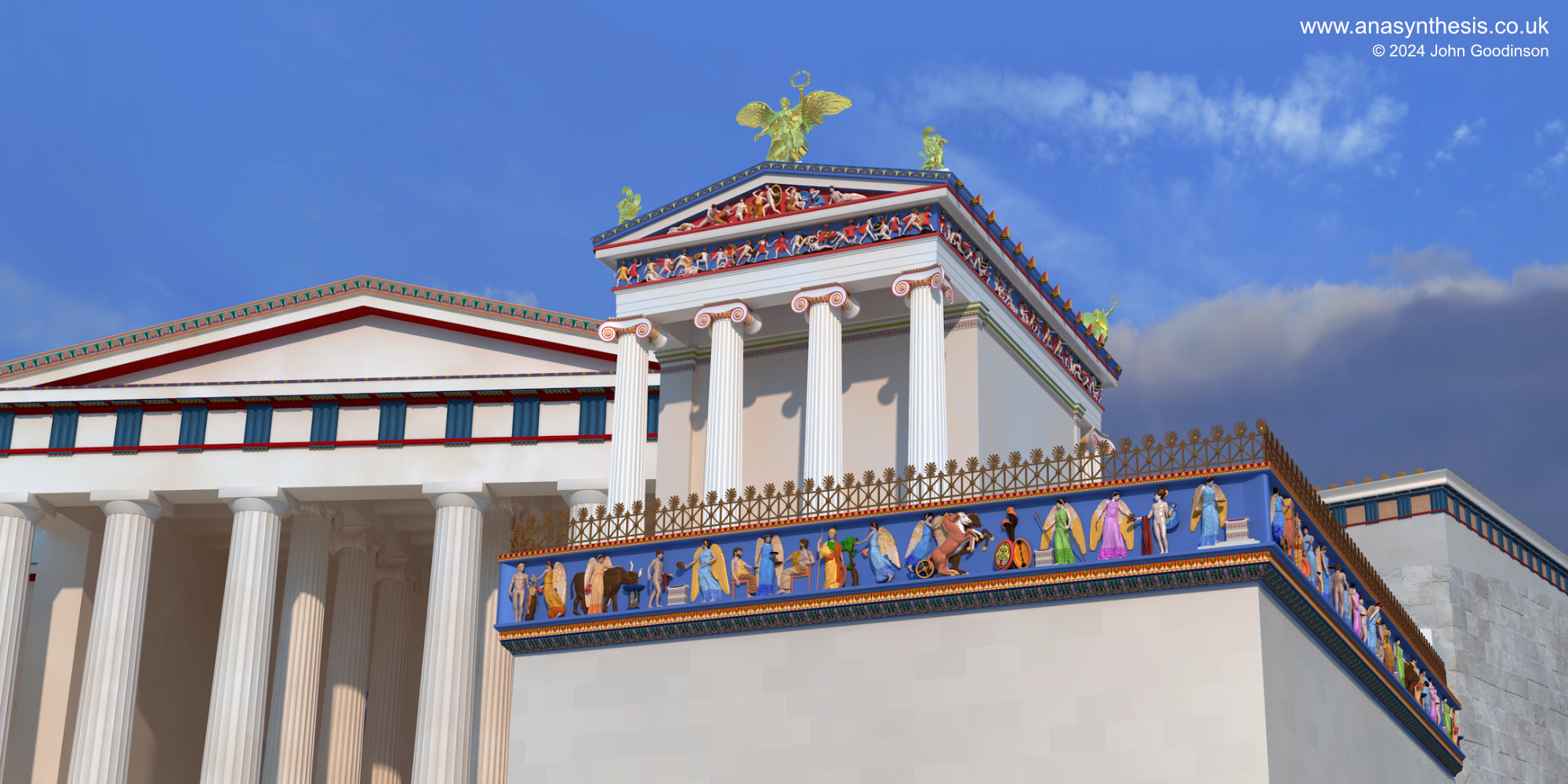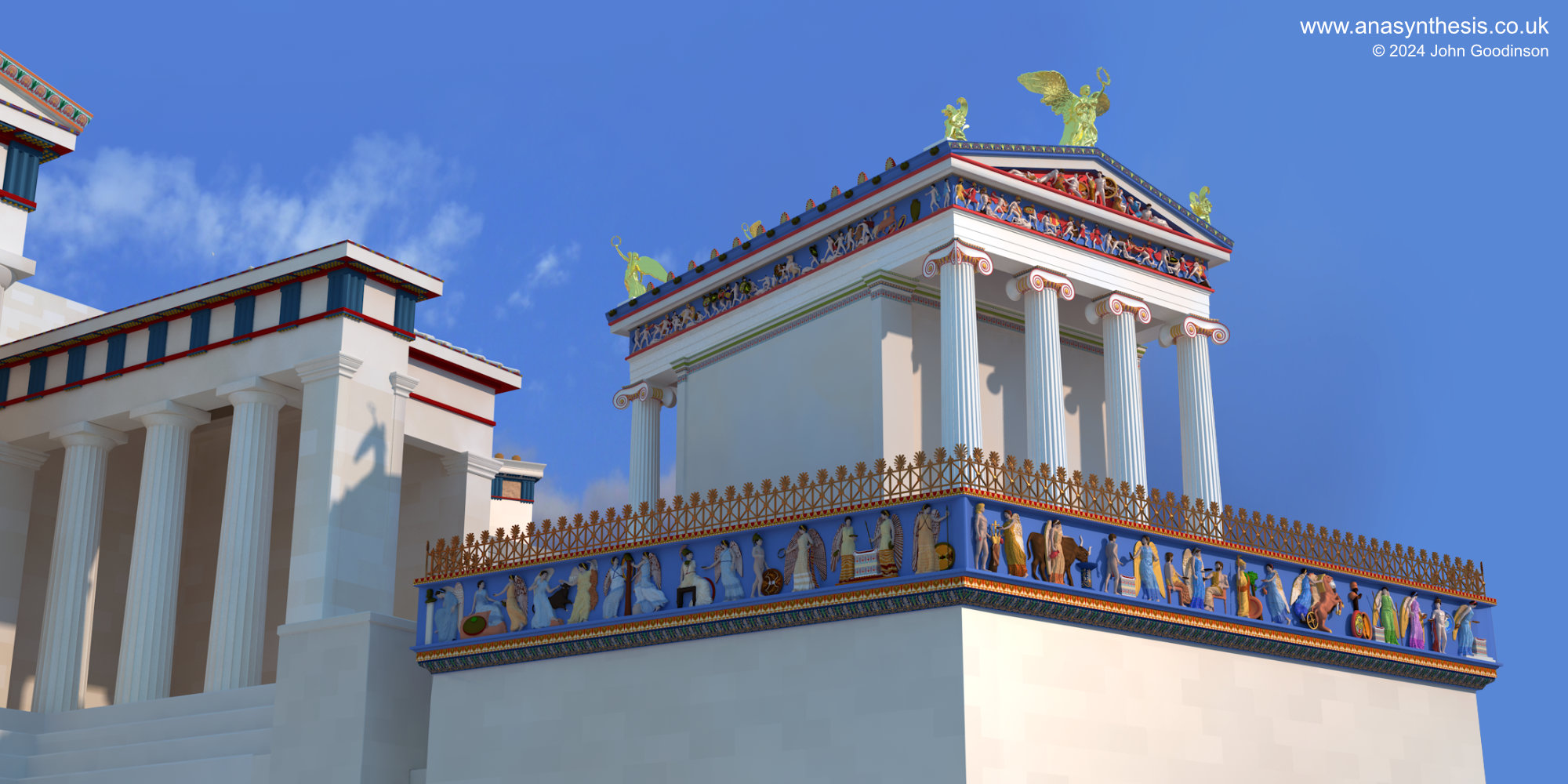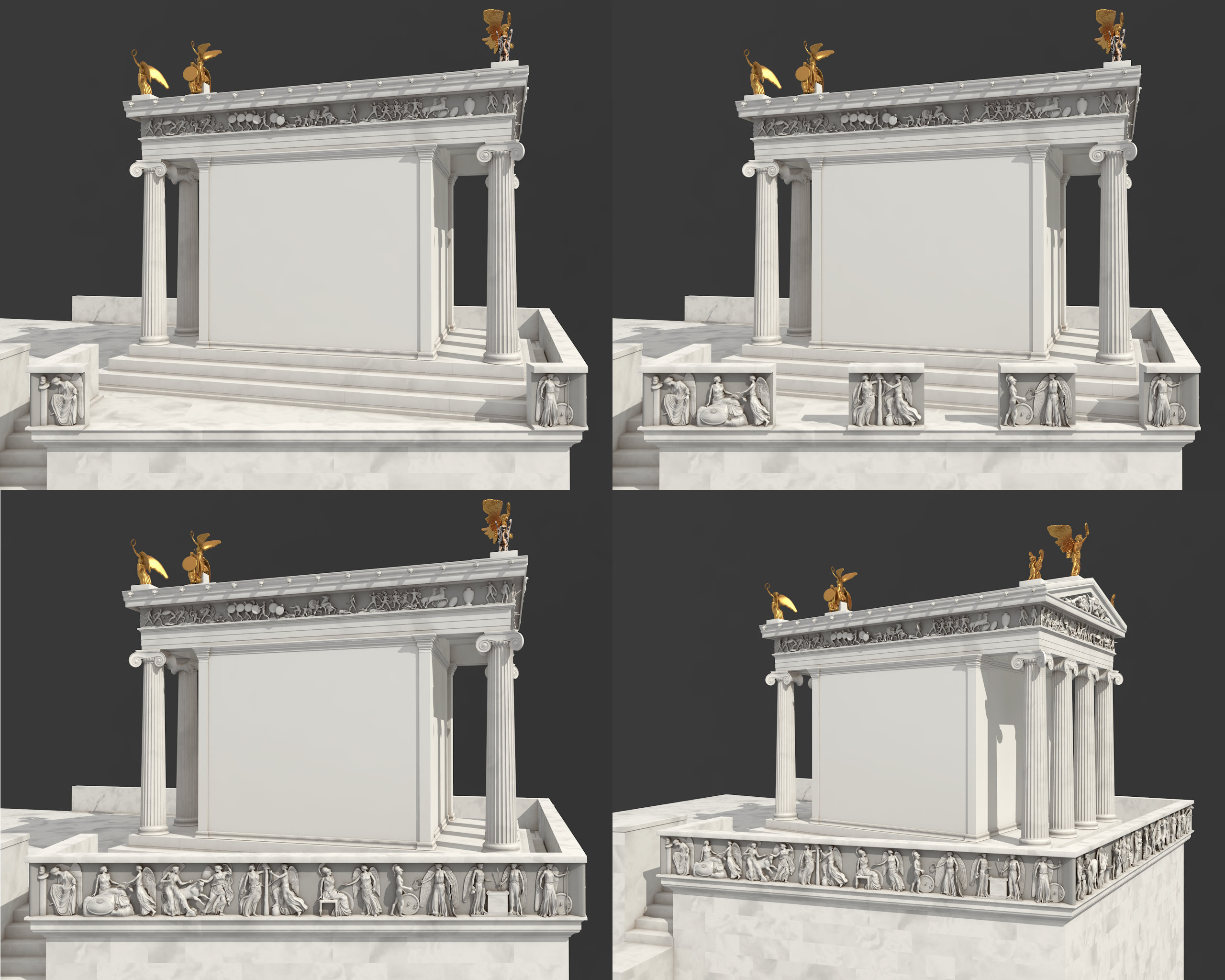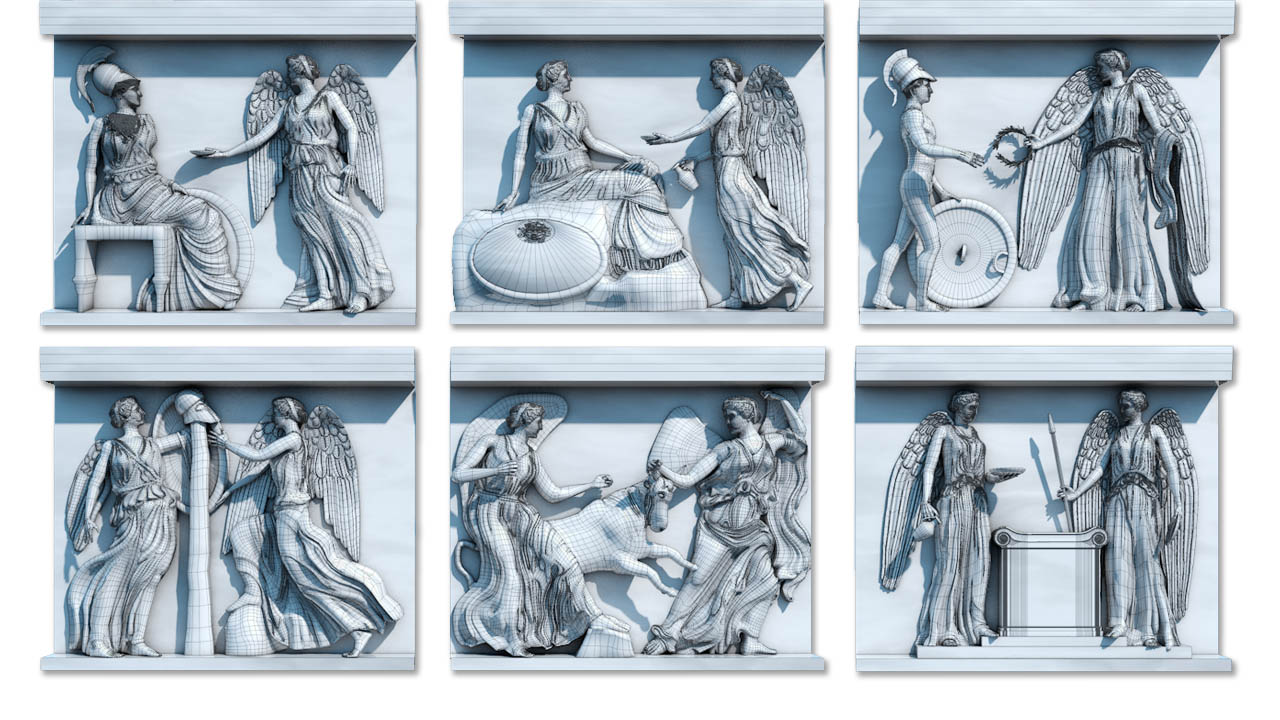The lavish Ionic temple of Athena Nike was completed in the late 420's BC, probably a year or two before the Peace of Nikias, the treaty signed between Athens and Sparta in March 421 BC that ended the first half of the Peloponnesian War.
The temple was built on top of the Mycenaean bastion overlooking the west slope of the Akropolis; at least two earlier shrines had been dedicated to the goddess on the same site. The building and temenos - or sacred precinct - seem to have been designed by the master architect Kallikrates, although some dispute remains on this point.
The date of the Nike temple decree, which set out the terms of construction, is also debatable; dates in the early 440s or in the mid 420s are given. Even so, it is virtually certain that the sanctuary was active by 423. By the late 420s, at the height of the Peloponnesian War, the new temple of Athena Nike housed a fully functioning cult.
In terms of its sculptural program, the Nike temple was lavish.
Proportionally, the little building was more heavily adorned than any Ionic temple in the history of Greek architecture. Its decoration was divided into five interconnected zones, each dramatically reflecting the theme of Athenian victory in battle.
First, the roof peaks were topped with massive Nikai akroteria in gilded bronze. This sculpture served as the crowning ornament for both the temple and the entire bastion.Second, the pediments held sculptured battle scenes. This was unusual at the time of construction because the pediments of Classical Ionic buildings were not normally adorned.The south, west, and north sides of the frieze showed three separate battle scenes. Two of these scenes, on the south and west side, almost certainly refer to specific, historical encounters. The south side depicts a conflict between Athenians and Persians. The scene almost certainly reflects the battle of Marathon. The west side shows a battle between Greeks. Most scholars believe that this scene is a representation of some contemporary or near-contemporary fifth-century conflict. There is far less certainty regarding the north frieze.
The Famous Parapet
The Nike temple's Fourth decorative zone was its famous parapet, set on top of a Pentelic marble shelf that was integrated into the temple's stereobate and euthynteria.- two important courses of the temple's foundation. This oft neglected archaeological detail proves that the parapet was seen as an integral component of the temple's design from the very beginning of the construction process. The parapet enclosed the Nike temenos on three sides and protected worshippers from the bastion's steep drop.
The parapet's large frieze was carved in high relief with three companies of luxurious, sensual Nikai setting up trophies and leading cattle to sacrifice in the presence of three seated Athenas.
Fifth and finally, the exterior walls of the Nike temple bastion seems to have been covered with votive shields. This adornment transformed the bastion itself into a gleaming tower of bronze, a permanent trophy dedicated to Athena Nike. From the crowning akroteria glimmering over the city, to the bastion encrusted with battle-field spoils, the Nike temple and its bastion forcefully communicated its theme of victory from the heights of the Athenian Acropolis.
From the crowning akroteria glimmering over the city, to the bastion encrusted with battle-field spoils, the Nike temple and its bastion forcefully communicated its theme of victory from the heights of the Athenian Acropolis.
Nike Temple Acroteria
The temple of Athena Nike was crowned with an elaborate set of roof sculpture. Architectural roof sculpture of this sort was known, in ancient Greek, as akroterion (singular) or akroteria (plural).
While we have lost the actual akroteria of the temple of Athena Nike, both the text from ancient inscriptions (epigraphical evidence) and the remains of the akroteria's statue bases (archaeological evidence) provide important data regarding the size, the composition, and the appearance of the Nike temple's mysterious, missing roof sculptures.
To start, we know for a fact that the akroteria of the temple of Athena Nike were made of gilded bronze, not marble which was far more common. This fact comes from two sources. First, the inventory lists of the Parthenon (which preserve a detailed record of the precious goods held in Athena's treasury) describe 'a piece of gold foil from the akroteria of the temple of Athena Nike'.
Second, the statue bases of the Nike temple's roof sculpture show evidence of deep sockets that would have received large, metal posts. These sockets in no way resemble the shallow plinth cuttings typical for the installation of marble sculpture, but are very similar to the thousands of known sockets used to mount bronze statues to their bases.
The epigraphical and archaeological evidence proves that the Nike temple's roof sculpture was made of gilded bronze.
But what did this gilded bronze roof sculpture look like?
One thing is certain. The akroteria were large. Far larger than we might have guessed. The evidence for the large size of the Temple of Athena Nike's akroteria is conclusive. The statue base for the central akroterion of the Nike temple was substantially larger than the central akroteria base of the temple of Rhamnous (ca. 420 BCE) and substantially larger than the central akroteria base of the temple of Asklepios at Epidauros (ca. 370 BCE).
Both of those temples were over twice as large as the Nike temple, yet their central akroteria bases are significantly smaller. The same can be said about the Nike temple's lateral akroteria bases.
The lateral akroteria bases of the Temple of Athena Nike were larger than the lateral akroteria bases of the Hephaistion in the Agora (ca. 450 BCE), a temple over four times the size of the Nike temple itself. Detailed analysis of all available comparanda allows for a height of between ca. 1.2-1.7 m for the central akroteria, and ca.. 0.85-0.95 m for the lateral akroteria. For its size, proportionally, the temple of Athena Nike boasted some of the largest akroteria in the history of ancient Greek architecture.
Why so big? Simple. The akroteria of the temple of Athena Nike were not conceived as the crowning ornament for the temple alone. Rather, they were conceived as the crowning ornament for the entire Nike temple bastion, as glimmering gilded reminders - visible to the entire city - that Athens, and Athens alone, was the true home of victory.
What did these large, gilded bronze represent?
Here, we enter the realm of speculation. The roof sculpture on the corners of the Nike temple were single figures. This is known from the remains of their statue bases.
Since the temple of Athena Nike is dedicated to Athena in her guise as the bringer of victory, and since winged nikai often serve as lateral akroteria, it is a short leap to suggest the the corner sculpture on the Nike temple would have been winged nikai.
As for the central akroteria, the archaeological evidence suggests three options: a tripod, a trophy with a shield at its base flanked by nikai, and a nike on a pillar with shield flanked by nikai. The latter two are more plausible than the first, since the Parthenon inventories record "a piece of gold foil from the shield on top of the [Nike] temple."
The last is perhaps the most compelling, since it is based on a contemporary central akroterion type designed by an artist long thought to be associated with the temple of Athena Nike: the master sculptor Paionios of Mende.
Paionios sculpted a large, gilded bronze nike placed over a shield for the temple of Zeus at Olympia. If this reconstruction is accurate, then the temple of Athena Nike's akroteria would have belonged to a set of victory monuments that were used to "broadcast" a series of spectacular victories won by Athens in the middle 420s, at the height of the Peloponnesian War.


